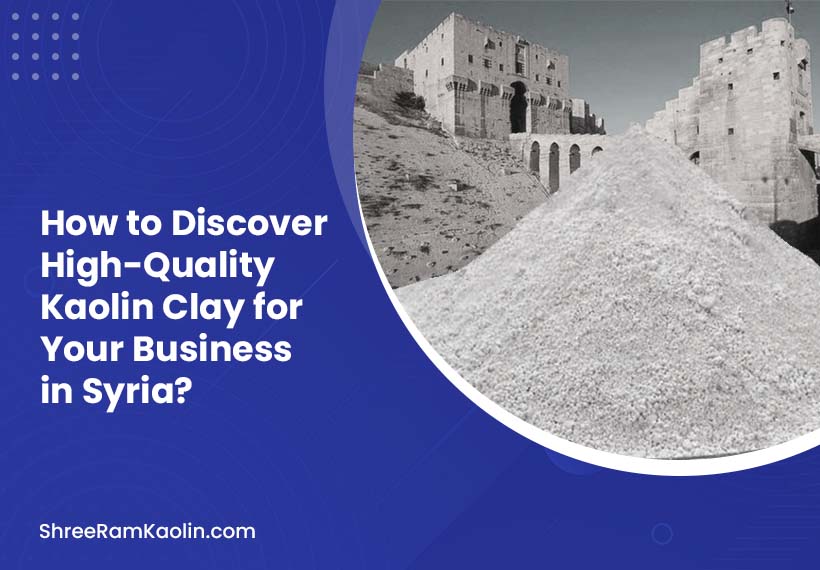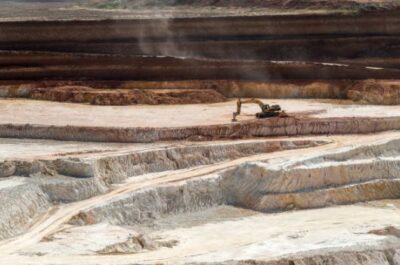How to Discover High-Quality Kaolin Clay for Your Business in Syria?

If you’re in the market for Kaolin clay for your business in Syria, understanding how to source high-quality clay is crucial.
Kaolin, a naturally occurring white clay, has a wide range of applications, from ceramics to cosmetics. This guide will walk you through the essential steps to discover and procure top-notch Kaolin clay for your business needs in Syria.
What is Kaolin Clay?
Properties and Uses
Kaolin (china clay), is an all-purpose natural mineral composed primarily of the mineral kaolinite that boasts unique properties that make it highly sought-after across various industries.
Notable among those benefits are exceptional whiteness, fine particle size distribution and inertness as well as good rheological behavior – making Kaolin an invaluable material that finds multiple uses across industries and applications.
Different Types
Kaolin can generally be classified according to its brightness and purity; however, there are various different varieties with distinct properties, including calcined (subjected to high temperatures) and water-washed varieties which undergo purification processes to eliminate impurities.
Knowing about each variety is critical in selecting an ideal product for your business requirements.
The Importance of High-Quality Kaolin for Businesses
Industrial Applications
Kaolin clay plays an indispensable part in many industrial sectors, from paper manufacturing where it serves as filler and coating material to improving brightness, opacity, and printability to production of ceramics, refractories, functional filler for paints plastics and rubber products.
Ceramics and Pottery
Kaolin is an integral ingredient in ceramic and pottery production, lending plasticity, strength and whiteness to final products. Due to its fine particle size and refractoriness, kaolin makes ideal material for producing porcelain stoneware ceramic goods of the highest quality.
Sources of Kaolin Clay in Syria
Major Mining Regions in Syria : Syria’s significant Kaolin deposits can be found in Aleppo and Hama, areas known for their extensive clay reserves that are mined both domestically and for export.
Prominent Suppliers and Mining Companies : There are various local companies in Syria engaged in mining and processing Kaolin clay. It’s essential that research be performed on suppliers that adhere to stringent quality standards as well as ethical business practices in their work practices.
You’ve discovered that Syria is a good place to source kaolin clay. However, if you can’t find high-quality clay there, consider partnering with Shreeram Kaolin for exports. We specialize in exporting premium kaolin clay to Syria, providing top-quality products ideal for diverse applications. Visit our website for more information.
Government Regulations and Policies : Syrian mining activities are tightly regulated to promote sustainable practices and environmental preservation, so familiarizing yourself with their regulations is paramount for legal and responsible sourcing practices.
Mining and Processing Techniques

Open-Pit Mining
Open-pit mining is an efficient means of extracting kaolin deposits located close to the surface. This practice involves clearing away overburden (such as soil or rock layers accumulated above deposits), in order to reach desired seams of kaolin.
Proper environmental management practices must also be put in place in order to minimize environmental degradation in surrounding communities.
Underground Mining
Where kaolin deposits lie deep underground, underground mining techniques may be utilized. This approach typically involves creating tunnels and shafts to access and extract precious clay deposits from deep below.
Underground mining requires specific tools as well as stringent safety regulations to safeguard workers.
Beneficiation Processes
Once extracted, kaolin clay undergoes various beneficiation processes to enhance its quality and meet application-specific demands. Such steps could include washing, magnetic separation, froth flotation or even calcination depending on its desired characteristics and intended application.
Sourcing High-Grade Kaolin Clay
Locating Reliable Suppliers
Finding reliable kaolin suppliers is essential to maintaining an uninterrupted source of high-quality raw materials.
Conduct research on local mining companies, traders and exporters with proven records for providing superior kaolin products; networking within your industry as well as attending trade shows can increase opportunities to connect with potential vendors.
Sampling and Testing Methods
Prior to signing an extended supply agreement, it is vitally important to carefully evaluate the quality of kaolin clay being provided. This can be accomplished using appropriate sampling techniques and thorough tests by accredited laboratories; key criteria to keep in mind include chemical composition, particle size distribution, brightness levels and any possible impurities present.
Physical and Chemical Analysis
Physical and chemical analysis techniques such as X-ray diffraction (XRD), particle size analysis and whiteness measurements provide invaluable insight into the properties and suitability of Kaolin for specific applications. Working closely with experienced testing facilities helps guarantee accurate and reliable results.
Factors Affecting Kaolin Quality
Composition and Impurities
Composition and purity are critical aspects of kaolin clay that determine its quality.
A higher kaolinite content with lower impurity levels such as iron oxides, quartz, and mica tends to be preferred for most applications; understanding geological context as well as performing detailed chemical analyses are indispensable in making an assessment on suitability of this kaolin product.
Particle Size Distribution
Kaolin clay’s particle size distribution can have an enormous effect on its performance in various applications.
Finer particle sizes tend to be preferred when high brightness and opacity are desired, such as paper coatings or ceramics; coarser particles might prove better-suited for applications where strength and insulation properties play a priority, such as refractories or fillers where strength plays an essential part of performance.
Color and Brightness
Kaolin clay deposits with higher brightness levels and whiter colors tend to be more desirable and sought-after, as these require less processing or additives in order to achieve aesthetic qualities such as whiteness or opacity.
Industries like paper manufacturing or ceramic production typically prioritize whiteness over opaqueness when selecting their deposits for manufacturing products with white paper and ceramic glazes or paste.
Sustainability and Environmental Considerations
Minimizing Environmental Impact
Responsible mining and processing practices are vital in order to minimize the environmental impacts associated with kaolin extraction, including taking steps such as implementing measures that lower water usage, minimize waste creation and mitigate air and noise pollution.
Adopting sustainable mining techniques while adhering to environmental regulations are vital parts of creating an ethical supply chain that functions at its full capacity.
Reclamation and Restoration
Once mining activities are concluded, reclamation and restoration should become top priorities. This requires filling and recontouring land areas affected by mining operations as well as installing drainage systems and revegetating sites to promote ecological recovery.
It’s crucial for responsible mining companies to have comprehensive reclamation plans in place in order to safeguard long-term sustainability of local environments.
Challenges in the Syrian Kaolin Industry
Political and Economic Instability
Due to Syria’s political and economic instability in recent years, its kaolin industry has faced serious difficulties.
Conflicts, sanctions, trade disruptions, and disruptions of logistics have greatly restricted kaolin clay’s availability for source or export; managing these obstacles effectively requires careful planning, risk analysis and understanding local dynamics.
Infrastructure and Logistics
Syria’s infrastructure can present logistical obstacles for the kaolin industry. Reliable transportation networks, supply chain management tools and accessing international markets are essential in maintaining an uninterrupted stream of kaolin products to businesses worldwide.
Conclusion
Finding and procuring high-grade kaolin clay for your business in Syria requires an in- mining methods, processing procedures and quality factors. By following the advice outlined herein you can navigate the complexity of Syrian kaolin industry to secure reliable supply of premium grade clay that fits all of your specifications – while prioritizing sustainability practices along the way to ensure long-term viability for operations.

